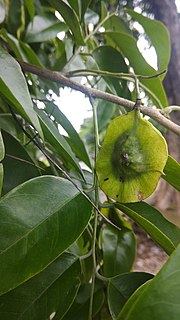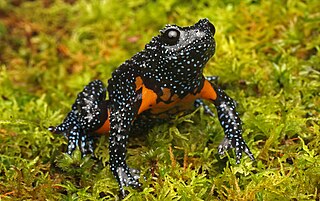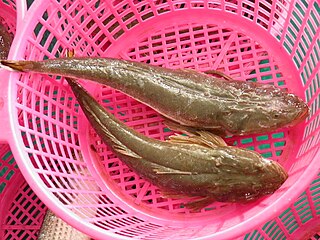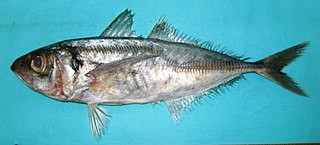Related Research Articles

The zebu, sometimes known in the plural as indicine cattle or humped cattle, is a species or subspecies of domestic cattle originating in the Indian sub-continent. Zebu are characterised by a fatty hump on their shoulders, a large dewlap, and sometimes drooping ears. They are well adapted to withstanding high temperatures, and are farmed throughout the tropical countries, both as pure zebu and as hybrids with taurine cattle, the other main type of domestic cattle. Zebu are used as draught and riding animals, dairy cattle, and beef cattle, as well as for byproducts such as hides and dung for fuel and manure. Some small breeds such as the miniature zebu are also kept as pets. In 1999, researchers at Texas A&M University successfully cloned a zebu.

Pterocarpus is a pantropical genus of trees in the family Fabaceae. It belongs to the subfamily Faboideae, and was recently assigned to the informal monophyletic Pterocarpus clade within the Dalbergieae. Most species of Pterocarpus yield valuable timber traded as padauk ; other common names are mukwa or narra. P. santalinus also yields the most precious red sandalwood in China known as Zitan. The wood from the narra tree and the Burmese padauk tree is marketed as amboyna when it has grown in the burl form. The scientific name is Latinized Ancient Greek and means "wing fruit", referring to the unusual shape of the seed pods in this genus.

The red-wattled lapwing is an Asian lapwing or large plover, a wader in the family Charadriidae. Like other lapwings they are ground birds that are incapable of perching. Their characteristic loud alarm calls are indicators of human or animal movements and the sounds have been variously rendered as did he do it or pity to do it leading to the colloquial name of did-he-do-it bird. Usually seen in pairs or small groups and usually not far from water they sometimes form large aggregations in the non-breeding season (winter). They nest in a ground scrape laying three to four camouflaged eggs. Adults near the nest fly around, diving at potential predators while calling noisily. The cryptically patterned chicks hatch and immediately follow their parents to feed, hiding by lying low on the ground or in the grass when threatened.

The Indian prawn, is one of the major commercial prawn species of the world. It is found in the Indo-West Pacific from eastern and south-eastern Africa, through India, Malaysia and Indonesia to southern China and northern Australia. Adult shrimp grow to a length of about 22 cm (9 in) and live on the seabed to depths of about 90 m (300 ft). The early developmental stages take place in the sea before the larvae move into estuaries. They return to the sea as sub-adults.

The Malayan tapir, also called Asian tapir, Asiatic tapir and Indian tapir, is the only tapir species native to Southeast Asia from the Malay Peninsula to Sumatra. It has been listed as Endangered on the IUCN Red List since 2008, as the population is estimated to comprise less than 2,500 mature individuals.

Pterocarpus indicus is a species of Pterocarpus native to southeastern Asia, northern Australasia, and the western Pacific Ocean islands, in Cambodia, southernmost China, East Timor, Indonesia, Malaysia, Papua New Guinea, the Philippines, the Ryukyu Islands, the Solomon Islands, Thailand, and Vietnam.

Titanosaurus is a dubious genus of sauropod dinosaurs, first described by Richard Lydekker in 1877. It is known from the Maastrichtian Lameta Formation of India.

The mangrove monitor, mangrove goanna, or Western Pacific monitor lizard is a member of the monitor lizard family with a large distribution from northern Australia and New Guinea to the Moluccas and Solomon Islands. Populations from the Marshall Islands, Caroline Islands, and Mariana Islands formerly classified in V. indicus are now considered to comprise two distinct species. It grows to lengths of 3.5 to 4 ft.

The smallbelly catshark is a catshark of the family Scyliorhinidae found in the western Indian Ocean near Somalia, the Gulf of Aden, and Oman, at depths between 1,300 and 1,840 m. Its length is up to 34 cm, although this measurement is of an immature specimen. The smallbelly catshark is not well known. It is found on continental slopes, and is probably caught by bottom trawlers. The reproduction of the smallbelly catshark is oviparous.

Melanobatrachus is a genus of narrow-mouthed frogs in the family Microhylidae. It is the only remaining genus in the monotypic subfamily Melanobatrachinae. It contains a single species, Melanobatrachus indicus, also known as the Indian black microhylid frog and Malabar black narrow-mouthed frog. It is endemic to wet evergreen forests of southern Western Ghats in Kerala and Tamil Nadu states of India. It has been recorded from Anaimalai, Munnar, Palni hills, Periyar Tiger Reserve and Kalakkad Mundanthurai Tiger Reserve

Melilotus indicus, sometimes incorrectly written Melilotus indica, is a yellow-flowered herb native to northern Africa, Europe and Asia, but naturalized throughout the rest of the world.
Mucor indicus is among the most important members of zygomycetes fungi. This dimorphic fungus is capable of production of several valuable products. Some strains of the fungus have been isolated from the traditional Indonesian food tempeh. M. indicus is nowadays used for production of several homemade food and beverages especially in Asia. This has also been successfully used as a safe nutritional source for fish and rat. The fungus is generally regarded as safe though there are few reports claiming that this is a pathogenic fungus.

The bartail flathead, also called the bar-tailed flathead, bartail blenny, gobi, Indian flathead or the Indo-Pacific flathead, is the type species for the fish genus Platycephalus. It is found in the Indian Ocean and western Pacific Ocean. The species has been recorded in the Mediterranean, having invaded as a Lessepsian migrant through the Suez Canal. However, although a number of specimens were caught in trawls in the late 1970s then none were caught until 2011, when one was taken off Lebanon. Following the revision of genus Platycephalus in Australia, Australian specimens previously assigned to this species are now considered a separate species, Platycephalus australis.
Indicus – Indian in Latin – may refer to:
The turquoise monitor is a species of monitor lizards found in Indonesia. Specifically, it is found on Halmahera Island and in the Maluku Islands.
The Rennell Island monitor is a species of monitor lizards found in the Solomon Islands archipelago. It is also known as the Hakoi Monitor. It belongs to the subgenus Euprepiosaurus along with the canopy goanna, the peach-throated monitor, Kalabeck's monitor, and others.
Marcgodinotius is a genus of adapiform primate that lived in Asia during the early Eocene. It is a monotypic genus, the only species being Marcgodinotius indicus. Anthrasimias is a junior synonym of Marcgodinotius and Anthrasimias gujaratensis a junior synonym of Marcgodinotius indicus.
Scaposodus rufulus is a species of beetle in the family Cerambycidae. It was described by Stephan von Breuning in 1961.

The Arabian scad is a species of jack mackerel from the family Carangidae which is found in the Western Indian Ocean.
References
- ↑ BioLib.cz - Scaposodus indicus. Retrieved on 8 September 2014.